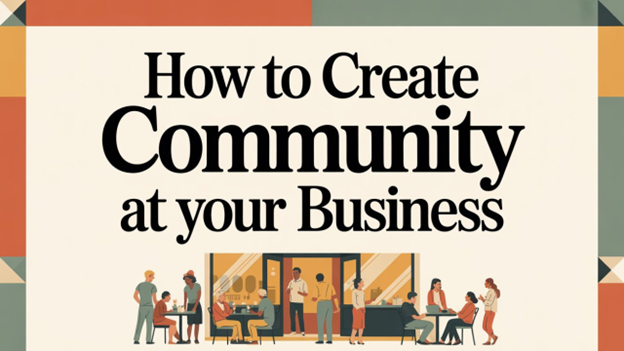December 8, 2025
If you have repeat customers, you already have the foundation of something powerful: a community. You just need to ensure they understand that. Not a punch-card club. Not just “regulars.” A real group of people who feel connected to you, your team, and each other. Community is what keeps people choosing you even when a cheaper, closer, or flashier option pops up. It is also a lot more fun than chasing new customers all the time. Here is how to turn those repeat visits into a community that loves coming back. Shift from Transactions to Relationships Most businesses stop at “Thank you, have a great day.” Community starts when you get curious. Ask yourself: · Do I know anything about the people who come back again and again? · Would I recognize them outside the business? · Do they feel like guests, or like familiar faces? You do not have to become everyone’s best friend. But a small shift in how you see them changes everything. When you view repeat customers as “our people,” you naturally look for ways to take care of them, remember them, and connect them. That is the beginning of community. Learn Names, Then Learn Stories One of the simplest, highest-ROI moves you and your staff can make is learning names and using them. “Hey, good to see you again” is nice. “Hey, Maria, how did your event go last weekend?” is loyalty. You can make a quick note after a conversation in your POS system or a notebook behind the counter. Capture just a few details: kids’ names, pets, big projects, favorite order. Train your team to glance at those notes before serving someone. You are not being intrusive. You are being attentive. In a world where most people feel invisible, that level of care is rare. Over time, you will know who just started a business, who is new in town, who is training for a race, who is caring for a parent. That is how your space stops feeling generic and starts feeling like “their place.” Create Simple Rituals People Can Join Community loves a shared ritual. This does not have to be complicated or expensive. Think about small traditions, such as a “regulars’ hour” once a week where you test new items, a wall of fame for long-time customers or milestone purchases, or a daily question on a chalkboard that everyone can answer. Rituals give people a reason to come back and something to talk about. When someone says, “On Fridays they always…” that is community behavior. You have given them a story to tell. Start a Club That Gives People a Reason to Return One of the strongest ways to turn repeat customers into a true community is to create a recurring club that meets at your business. The club should fit your brand and your customers’ interests. For example: · A bookstore or café could host a monthly book club or writers group. · A yarn, craft, or gift shop might host a weekly knitting circle or “maker morning.” · A fitness studio could run a “goals group” that meets once a month for coffee and conversation. · A wine bar could host a “Wednesday Tasting Club” where members try a new flight together. Keep it simple: 1. Choose a consistent day and time. 2. Give the club a name so it feels special. 3. Offer a small perk for participants, such as a discount, early access to products, or a reserved table. Over time, the club becomes a steady heartbeat in your business. People come not only for what you sell, but for the friends they know they will see there. Turn Repeat Customers Into Insiders People do not just want to buy from you. They want to feel in on it. Treat your regulars as insiders, not just transactions. You might give them early access to new products or menus, “first to know” messages about special items or events, or a quick behind-the-scenes look at what you are working on next. Ask for their input: “We are thinking about adding X. What do you think?” “We have two logo options for this new product. Which one would you pick?” When customers feel like insiders, three things happen: they show up more often, they bring people with them, and they defend you when someone criticizes you online. Make Your Space a Place to Connect Community is not just between you and your customers. It is also between your customers and each other. Look for small ways to help that along. Arrange seating so people can sit, not just stand in a line staring at their phones. Host tiny, low-pressure events: coffee tastings, lunchtime learning sessions, local maker pop ups, or “meet the owner” Q&As. When it feels natural, introduce people: “You two are both new business owners on this street, you should meet.” “You both come in after the school run. Have you met?” You are not planning a conference. You are creating moments where conversation is possible. Those moments are what people remember. Share Their Stories, Not Just Your Promotions If every post or email is “Here is what we are selling,” your marketing will always feel like noise. Community-building content looks different. You highlight customer stories and shared moments. You might feature short spotlights of regulars, with a photo and a quote about why they come in. You can show customers enjoying your space (with permission, of course), or share stories of how your customers support one another, like referrals or collaborations that started at your business. This makes featured customers feel seen and signals to everyone else, “People like you belong here.” Suddenly your brand is about more than what is on the shelves or the menu. It’s about who gathers around them. Build Light Systems So It Survives Busy Season Community sounds warm and fuzzy, but it works best with a little structure behind it. To keep it going even when you get swamped, create a simple “regulars” tag in your POS or email system. Add a short team habit, such as “two genuine conversations per shift” or “ask one follow-up question of a regular each day.” Once a month, review who you are seeing a lot and who you have not seen in a while. You do not need a complicated points program. You need a repeatable way to notice, remember, and appreciate the people who show up. The Quiet Advantage of Being “Their Place” When customers feel like they are part of a community at your business, a few things shift quietly in your favor. They are more patient when something goes wrong. They choose you even when a big chain runs a sale. They tell people about you without being asked. In a world where so many experiences feel rushed and anonymous, being the business that remembers their name, knows their story, invites them into clubs and rituals, and connects them to others is not just nice. It is a serious competitive advantage. You are not just building foot traffic and revenue. You are building a small, loyal neighborhood around your business, one repeat customer at a time, and that feels really good for everyone involved. Read More: 5 Customer-Focused Strategies to Build Loyalty and Drive Growth Hospitality is the Hidden Edge: Why Emotional Connection Drives Customer Loyalty Winning Back Lost Customers: Smart Strategies to Reignite Trust and Revenue -------- Christina Metcalf is a writer and women’s speaker who believes in the power of story. She works with small businesses, chambers of commerce, and business professionals who want to make an impression and grow a loyal customer/member base. She is the author of The Glinda Principle , rediscovering the magic within. _______________________________________ Medium: @christinametcalf Facebook: @tellyourstorygetemtalking Instagram: @christinametcalfauthor LinkedIn: @christinagsmith




